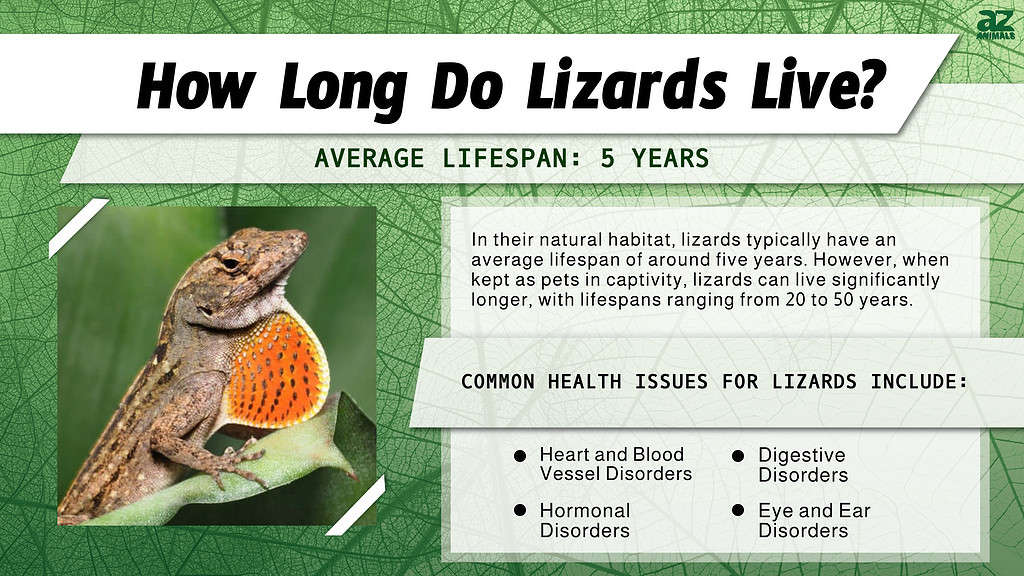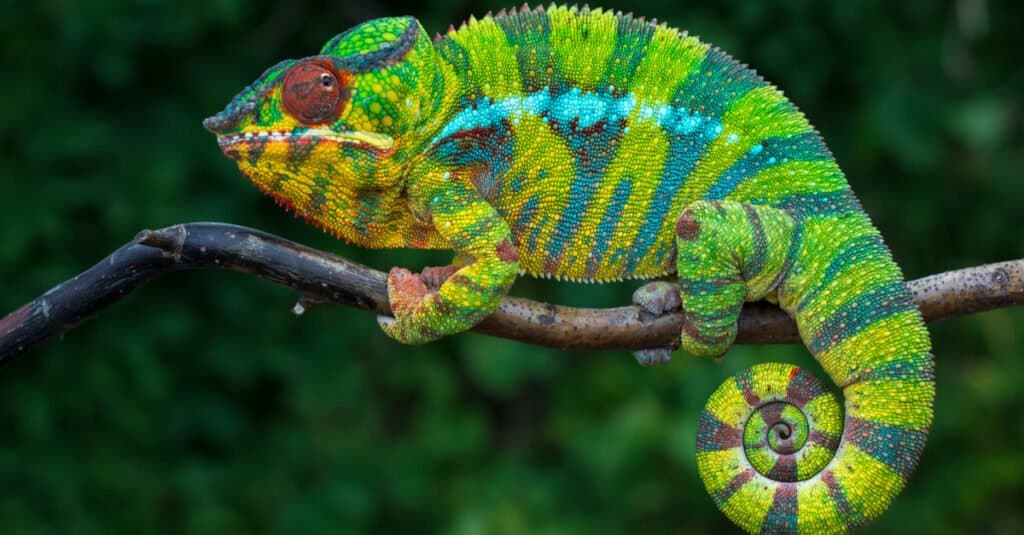
Lizards are reptiles that can be found all around the world. In fact, there are more than 6,000 species of lizard. They come in a ton of different varieties which include four legs, two legs, and some with no legs at all. Some lizards are exclusively omnivores, other herbivores, and still others carnivores.
Lizards are cold-blooded creatures, which means they rely on their surroundings to keep their bodies warm. They use the sun’s heat to elevate their body temperatures, and they are active when their bodies are heated. They are an incredibly interesting species of animals and we’re going to go into a deep dive into them today. We’ll find out just how long lizards live and what impacts their lifespan. Let’s dive in!
The Average Lizard Lifespan

Alone, lizards survive for up to 5 years but in captivity, they could live 10 times more.
©Steve Bower/Shutterstock.com
In the wild, a lizard’s average lifespan is about 5 years. However, when living in captivity as pets, lizards are able to live anywhere between 20-50 years of age! A lizards’ lifespan is heavily impacted and dependent on its habitat and the amount of space provided to it. The species type will also impact how long lizards live.
Let’s take a look at the lifespans of a few memorable lizard species:
- Leopard geckos: In ideal conditions, a leopard gecko may live for up to 20 years. It is one of the lizard species with the longest lifespan.
- Bearded dragons: Bearded dragons can live with you for up to 15 years if properly cared for.
- Crested geckos: Crested geckos can live anywhere between 15-20 years.
Recent studies on the telomere length and lifespan of desert lizards, published in the Journal of Thermal Biology, have begun to look into how climate change will impact many species. It was discovered that just one week of exposure to a simulated heat wave dramatically reduced telomere length and reduced lizard overwinter survival. As a result, heat waves may have a negative impact on the lifespan of the desert agama, possibly causing lizards’ lifespans to decline as a result of climate change.
The Average Lizard Life Cycle
There are three distinct stages in the lizard life cycle. To have a better understanding, let’s examine the lizard’s life cycle in detail.
Egg
The majority of lizards will lay eggs. Most lizard eggs have leathery shells that enable water to flow. Female lizards will even bury their eggs to protect them from predators. The embryo grows inside the eggs at this time. Lizards use their egg teeth, known as a caruncle, to shatter the eggshell. The newborn lizards stay within the eggs for 12 to 24 hours after cracking the egg shell in order to absorb all of the leftover yolks from the egg.
Juvenile Stage
Juvenile lizards are entirely capable of fending for themselves after hatching. Most lizard parents do not offer care or protection for their offspring. Outside of growing larger as they age, there aren’t many notable changes that a juvenile lizard will go through before becoming reaching the adult stage.
Adult Stage
Lizards become adults when they reach sexual maturity. The mating process differs across species. Males attract females during the mating process by extending their frill to gain their attention.
What Impacts The Lifespan of Lizards?

Predators like birds, foxes, and snakes are some of the biggest threats to lizards.
©Jan Bures/Shutterstock.com
There are many factors that will impact a lizard’s lifespan in the wild. These threats include habitat loss. climate change, invasive species, predation, and overexploitation.
One of the most serious threats to amphibian and reptile populations is habitat loss and destruction. Habitat loss and degradation have been blamed for declines in both population numbers and species variety in lizards. Wetland destruction gets rid of breeding places for the different species and begins to cut down on populations of amphibians and aquatic reptiles.
There are also many predators that lizards must watch out for in the wild.
These include:
Since many lizards live in rainforests, they have learned to employ safety mechanisms to keep them from being easy prey. As a result, they can have either a green or brown exterior to match the trunks and branches of trees or the foliage and leaves of the trees. Lizards that live in trees are also good climbers, and some have claws to grasp onto the branches. Others have toe pads that help them to cling to tiny branches and leaves. All of these characteristics and abilities equip them with natural defense from their many predators.
How To Extend The Life Of Your Pet Lizard
After learning everything there is to know about lizards and their lifespan, you may be eager to bring home a little, friendly pet lizard. As with all of our pets, we want to keep them alive for as long as we can. Keeping your lizard happy and healthy isn’t hard, especially not when you know all of the right things to do.
Here are the top tips to help extend the life of your pet lizard:
- Feeding them a proper diet. Since different lizard species are either omnivores, herbivores, or carnivores it is important to feed them according to their diet in the wild. Live crickets, mealworms, and waxworms are preferred by carnivorous lizards. Dandelions, romaine, watercress, green beans, bok choy, shredded carrot, papaya, cactus fruit, and berries should be fed for herbivores. While omnivorous lizards require a mix of the aforementioned.
- Proper housing. Most lizards thrive in aquariums that have been converted into terrariums. The bigger the tank, the better for your lizard. Once you’ve chosen the right tank, it is important to keep the temperature regulated for your lizard. They are unable to function in what we perceive to be pleasant room temperatures. Lizards, like other reptiles, rely on heat from outside sources to keep their bodies working. Without heat, they cannot move and cannot digest their food.
- Providing water. Your lizard needs water on a regular basis. This can be passively given in a shallow dish or with a bubbler bowl. Bubbler bowls are intended for lizards that do not drink still water.
The photo featured at the top of this post is © reptiles4all/Shutterstock.com
Thank you for reading! Have some feedback for us? Contact the AZ Animals editorial team.






